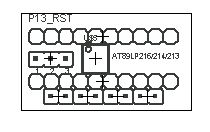TSSOP - PDIP adapter
A small PCB in Eagle format to adapt LP213 / LP214 or LP216 in
TSSOP Package to 20pin PDIP
(download in zip, inc. Atmel LIB)

| .....tools.....links......notes for developers |
Some 8051 tools and links
| Assembler TASM |
http://www.bookcase.com/library/software/msdos.devel.cross-asm.html |
|
| C Compiler µC/51 V1.20.04 | ||
| Basic Compiler Bascom 8051 |
http://www.mcselec.com
|
|
| PCBs / Leiterplatten | www.basista.de |
If you want to test LP213/214/216 in your existing 20 pin PDIP
Design:
| LP213 / LP214 / LP216
TSSOP - PDIP adapter |
A small PCB in Eagle format to adapt LP213 / LP214 or LP216 in
TSSOP Package to 20pin PDIP |
LPTSSOP-PDIP |
AT89LP2052 / AT89LP4052 / LPx052EVAL development informations
AT89LPx052 Crystal (XTAL1-XTAL2) is not working?
The default settings might be
that the XTAL Osc. Bypass fuse is enabled.
Ports not
working?
Default settings: all Ports are configured for input mode after
reset. You have to set P1M0, P1M1, P3M0 and P3M1.
Atmel ISP Programming Cable
Please take a look to our flash / programmers section
Test PWM via ser. Port
We have some small assembler / hex code available to test PWM settings
/ PWM Modes and you can control the settings with a small vb utility.
Alternatives to PWM?
If you need a different way for PWM then you should have a look to the 16 bit
timer and Timer interrupts. Because the timer register counts each clock
cycle you easily can achieve various frequencies and pulse width
settings.
Questions ?
Any input is welcome: Mail
j.hulzebosch@gms2000.de